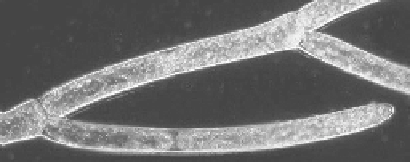Environmental Engineering Reference
In-Depth Information
7
Antioxidant Compounds
The oxidative stress that is induced by oxygen radicals is largely responsible for
various degenerative diseases of the central nervous system (CNS), as well as the
normal process of aging. Protection from aging, mutagenesis, carcinogenesis, etc.,
is mainly due to antioxidant effects. The antioxidants or radical scavengers are
compounds that inhibit or delay oxidation of other molecules. Natural antioxidants
include phenolic compounds, nitrogen compounds, vitamin C (ascorbic acid), vita-
min E (tocopherols), lavonoids, phenolic acids, carotenoids, etc.
CLADOPHORA GLOMERATA
(LINNAEUS) KUTZING, 1843
Phylum: Chlorophyta Class: Chlorophyceae
Order: Cladophorales Family: Cladophoraceae
Distribution: Throughout the world's freshwater ecosystems, Europe, North,
Central, and South America, Southwest and Southeast Asia
Habitat: Rivers, streams, lakes
Description: This singly ilamentous species is a rapid colonizer of rocky
streambeds. The thalli of uniseriate dark green ilaments (200 cm long)
are provided with apical and intercalary sheaths. The cells (100 × 100 µm)
are multinucleate and cylindrical and have parietal chloroplasts. The apical
cells (1,100 × 90 µm) are cylindrical and fairly tapering. The akinetes are
formed in this species only during unfavorable conditions.
Compounds and activities: The crude methanol extract of the species has shown
antioxidant, antibacterial, and antiprotozoal activities. The values of total
phenolic and lavonoid contents of the extract of this species were 3,077 ±
105 mg gallic acid equivalent/g and 595 ± 23 mg quercetin equivalent/g.
The scavenging activity of 2,2-diphenyl-1-picrylhydrazyl (DPPH) radicals
(920 ± 42 µg/ml IC
50
value), iron chelating activity (IC
50
= 971 ± 39 µg/ml),
and scavenging activity of nitric oxide (0.20 ± 0.01 mg/ml IC
50
) have been
recorded in this species (Soltani et al.,
2011).
131


